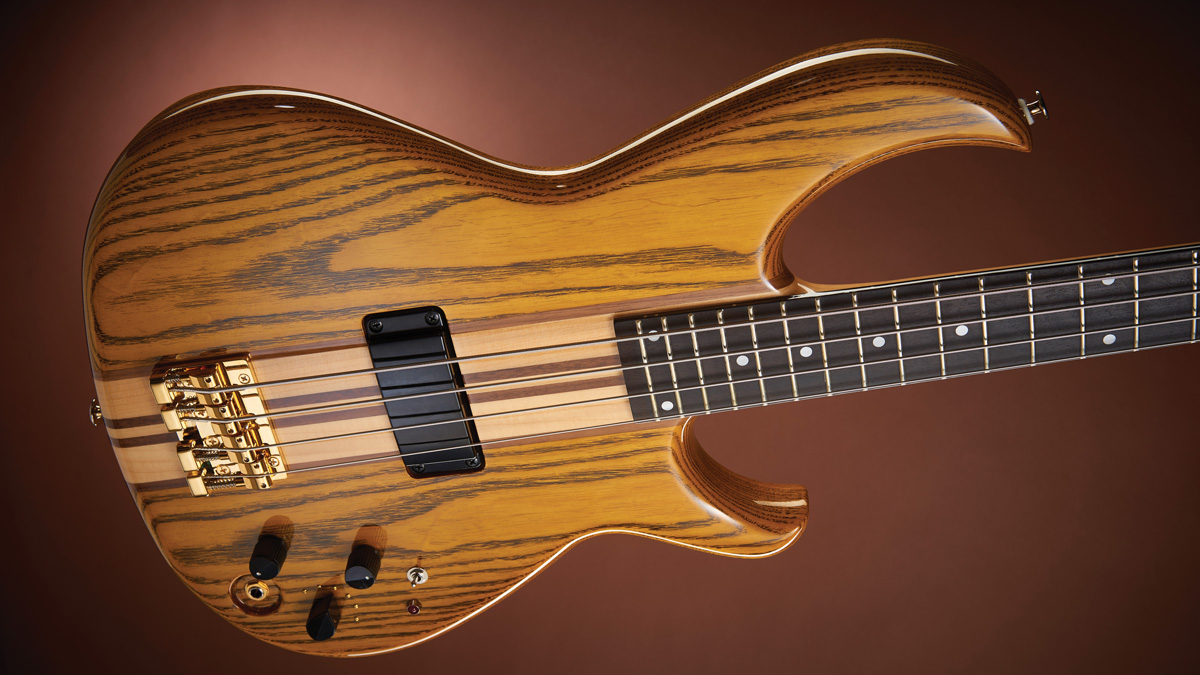MusicRadar Verdict
An utterly wonderful reissue of a classic design.
Pros
- +
Very playable. Excellent tone options. Replicates classic feel and tone.
Cons
- -
None, although the inclusion of a hard case would have been nice.
MusicRadar's got your back

Aria SB-1000RIB

Aria SB-1000RIB
Ah yes! The late 70s was a fine era for bass guitars.
Why, we remember when Fender ruled the roost and no-one really thought that Japanese luthiers could ever seriously compete in the world of bass. This all changed and here we are in 2016, with a brand-new reissue of Aria's finest ever product to review.
It was good enough for Cliff Burton of Metallica, John Taylor of Duran Duran, Jack Bruce and other greats: is it good enough for us?
Build Quality
As you're paying over two grand for a mass-produced bass guitar, you justifiably expect the SB-1000 to be a truly world-class product, aesthetically and functionally. Run your fingers over the engineering and the neck: you'll find no flaws or sharp fret ends, and the finish - ours is an imperial-looking 'Oak', but you have transparent colour options too - is to die for. Thick, glossy and bringing out the wood's natural features, the finish feels impenetrable.
Running down the bass, we begin with that classic extended headstock: perhaps other manufacturers would have considered reducing its considerable length to account for modern, space-saving tastes, but thankfully Aria have not done so.
The Gotoh tuners do what Gotohs always do and work perfectly. The ebony fingerboard atop the five-ply maple/walnut neck feels hard, solid and supremely resonant.
There's a brass nut, just to add to the feeling of strength that the SB-1000 emanates, although there's no deliberately 'vintage' feel either. This may be a classic instrument, but it's also a thoroughly modern one.
A single immovable humbucker invites your thumb to rest on it as you flick through a quick rendition of Duran Duran's Planet Earth bass-line (or whatever takes your fancy), while a large red LED tells you that your batteries (two of them, 18-volt fans) are alive and well. A single volume and tone are available, assuming you wish to bypass the large, six-position rotary tone selector that is at the heart of this great, slightly unorthodox instrument's appeal. But why would you want to do that...?
Sounds and Playability
Out of the box and onto your lap, the Aria plays smoothly and easily, set up with a slick, low action and benefiting at the top end from that neck-thru joint and the easily navigable heel. Sure, playing up at the 24th fret requires a fine balance as the neck feels so long and the bass is a fairly heavy beast, but once you're in a comfortable position you'll be soloing away like it's going out of style (again).
While the standard tone control does its job just fine, with a range that is easily accessed and usable, this bass is known for a particular, distinctive tone made up of crunchy mids and a snappy top end.
Aria presumably knows this, because the default position on the rotary control (labelled in true heavy metal fashion as the 'Pickup Attack Mode Selector') is that recognisable John Taylor tone - in other words with the control turned to full clockwise. This sound may be hard to explain in words, so YouTube some early Duran Duran and all will become clear. Bitey, chunky, crispy, zippy - all these pointless adjectives define a killer tone that is basically a nicely-gauged dose of mids.
However, this isn't just a bass for New Romantics - it offers something for everyone. Colossal low end is achievable thanks to the neck-thru construction and a dexterous twist of the tone selector. Slapping is a dream: you'll be Mark King-ing it all day thanks to the speedy response of the ebony board and the twang of the pops when they bounce off the brass nut. It's a shame to give the thing back to Aria...
This splendid bass is not cheap by any means, but you're paying for a precision-engineered reissue of a classic instrument. There's no self-conscious replicating of older features: indeed, the original 1970s SB-1000s had an arguably inferior bridge, which has been upgraded for modern requirements. Essentially Aria has thought long and hard about what players want and will pay for, and the results are undeniable. Full marks.
“Built from the same sacred stash of NOS silicon transistors and germanium diodes, giving it the soul – and snarl – of the original”: An octave-fuzz cult classic returns as Jam Pedals resurrects the Octaurus
What’s the buzz? Meet Yellowjacket, Cherry Audio's recreation of EDP’s trend-setting Wasp from 1978
“A fabulous trip through all eight songs by 24 wonderful artists and remixers... way beyond anything I could have hoped for”: Robert Smith announces new Cure remix album









